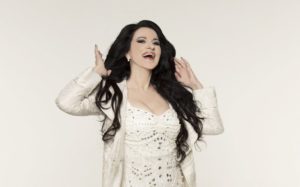
Review: ‘Angela Gheorghiu – A Life For Art’
The Soprano’s Autobiography Is a Quick Read, Though Unbalanced Structurally Throughout
By David SalazarAutobiographies are interesting artifacts.
They give the subject in question an opportunity to set the record straight and create the point of reference for their particular life experience. As we glance through autobiographies, it is always curious to wonder at the particular perspective being offered on certain items and how other perspectives might differ or coincide with the account given.
Soprano Angela Gheorghiu is one of the most fascinating opera stars of the past few decades, known as much for her incredible artistry as she is for her intense personality, many noting that she is the modern embodiment of the traditional diva. Gheorghiu’s artistic life has often been overshadowed by the antics associated with her life off the stage, generating perhaps a number of different points of view on this particular artist.
With her autobiography, “Angel Gheorghiu: A Life For Art,” which she co-authored with Jon Tolansky, the soprano seems intent on setting the record straight in many instances.
The book is set up as an extensive interview, with questions setting up topics and Gheorghiu giving answers. The framing device is undeniably unique as it is not customary to see this style utilized in a book of this kind, but the choice works on a number of fronts. It creates for a more casual read that also allows for greater flow. If you want to skip to something else, the questions provide a perfect means to find what you are looking for and find your answer.
Finally, it gives it a sense of authenticity of the soprano making a confession rather telling her story in her manner. The interview makes us feel that someone else is controlling the flow of conversation, as would be customary in an interview setting. Of course, we all know that Gheorghiu has edited the book to tell her story the way she wants it told, but as is with art, framing and context always provide new ways to interact with the audience.
As to the content itself, the book feels slightly unbalanced in its structure. We get quite a few chapters about the soprano’s child life in Romania and how the sociopolitical context affected her burgeoning career. These opening chapters are replete with details that give us a great sense of Gheorghiu’s world as she embarks on her great artistic journey. We learn of her closest friends growing up, the people that inspired and supported her as a young singer, her challenges with communists during her conservatory years, and her passion for her family.
Then she leaves Romania and the entire style of the book shifts. We get important episodes of her career, but it all flies by rather quickly and ultimately feels rather incomplete. Interspersed with her career trajectory we get the expected details on her challenging private life and then some moments where she goes into depth about her perspective on her artistry and some of her major roles.
Of the latter, it often feels like there could be so much more, as these are easily the most exciting and intriguing sections of the book. Learning of how she views Violetta as a role for one soprano voice (not three, as has become the cliché) or how she views Adrian Lecouvreur’s idealization of her art or why she never felt she could sing “Madama Butterfly” onstage, is riveting. We find ourselves truly appreciating what she has to offer as an artist and looking back and cross-referencing these concepts with her recordings themselves proves an illuminating experience. Honestly, the entire book could have been about her views on her roles and that would have been worth the price of admission.
But the rest of the material feels skimmed over, especially in the closing chapters of the book, which feel like they are in a rush to come to an end. The rich detail of those opening chapters is often lacking, ultimately making most things feel like footnotes in her life.
Then there is material that drags down the book, especially separate text boxes littered throughout with personal accounts from people that have impacted or been impacted by the soprano at some point in her life. These sections tend to be hit or miss with some providing unique encounters (here’s looking at Peter Gelb), but at others simply acting as opportunities to heap praise on the soprano. It gets a bit repetitive after a few times and by the end of the book, I found myself skimming past most of these boxes.
Those looking for gossip regarding the soprano with regards to the soprano’s personal life will undoubtedly find much to savor over as Gheorghiu aims to set the record straight with her reader. As always with these accounts of the personal variety, it is interesting to remember that point of view is everything.
Ultimately, those fascinated by the soprano will find more to enjoy, while those merely curious to understand her better will undeniably find new insights into this great artist.
Categories
Reviews

